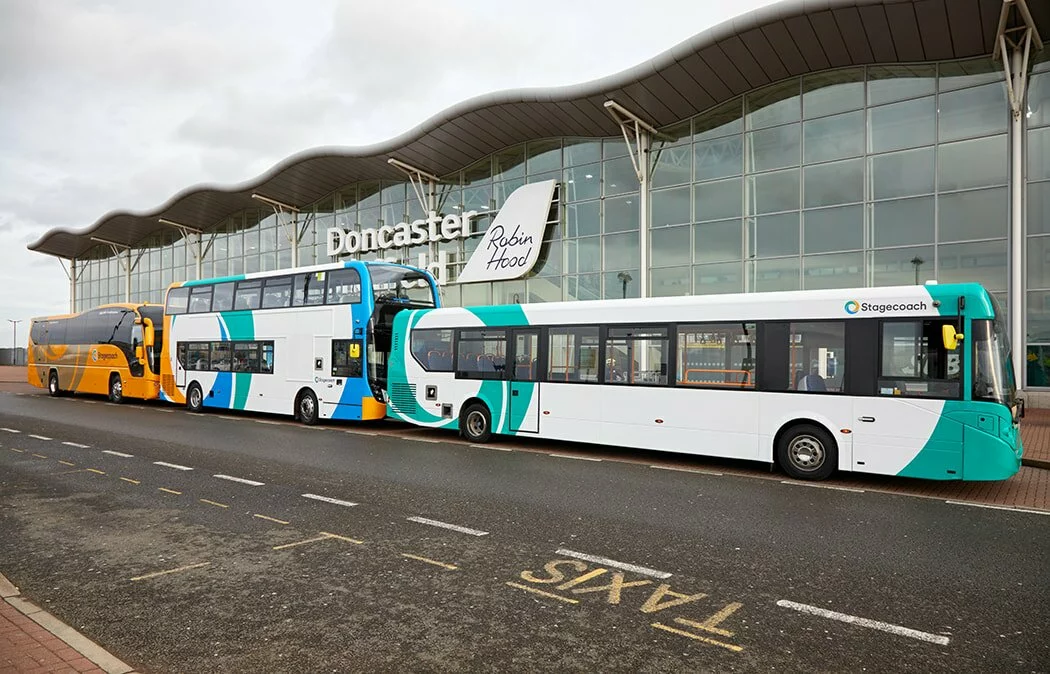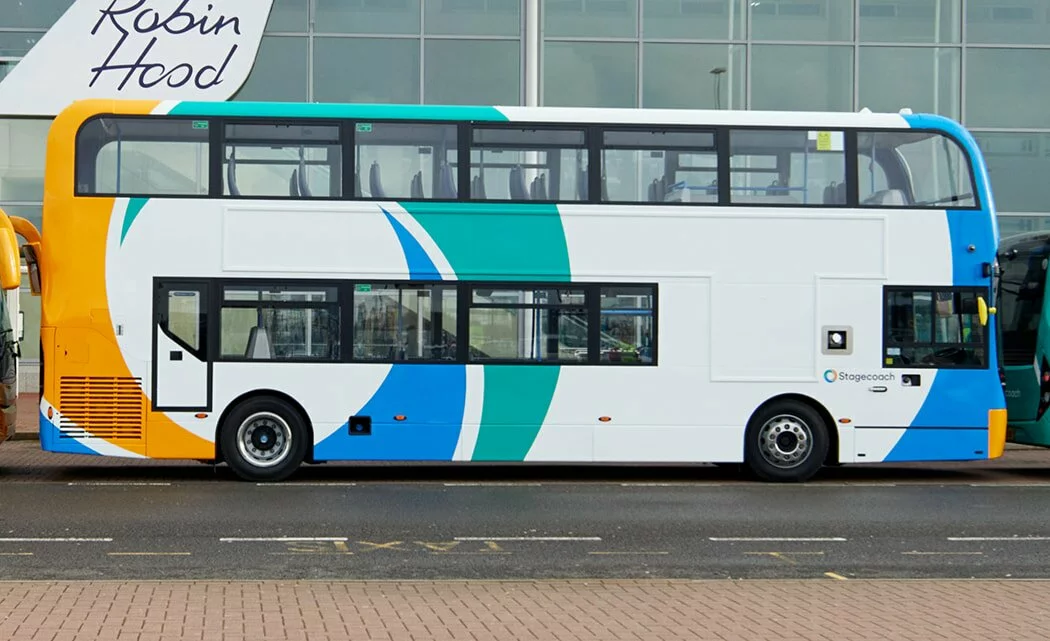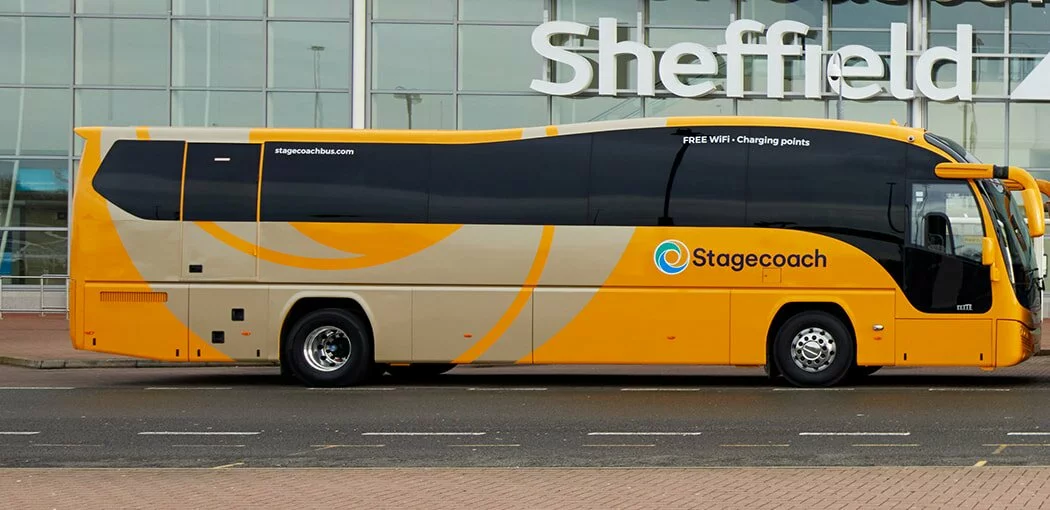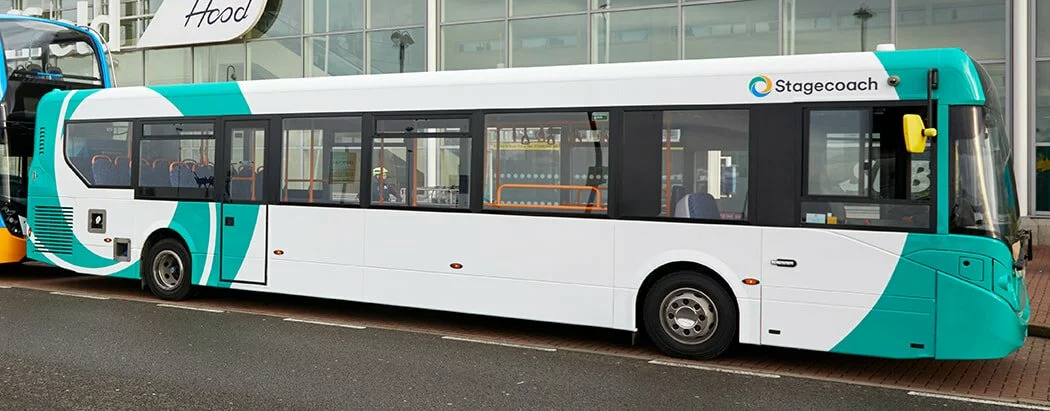 |
| The new liveries on show at Robin Hood Airport
Stagecoach has announced details of a new colour scheme for its fleet. The present bold red, orange and blue on a white background is to be replaced by what appears to be a a more subdued (some might say insipid) selection of colours with the white background seemingly becoming more prominent.
There are actually three new liveries, one each for the the three "categories" that Stagecoach will split its services into.
Local buses, which are described as "everyday community buses that take people to work, education, hospitals, leisure activities with friends and family and life’s important moments". These will be basically white with orange, pale blue and pale green swirls of colour as shown on the double-decker below, although it will also appear on single-deckers. Most Lancaster buses will fall into this category.

The new "local" bus livery.
Longer distance – "buses with added comfort and value for customers that need to take a bus beyond the place they live". Some Lancaster services certainly do take people "beyond the place they live", to Blackpool, Preston and the Lake District. However as the example shown in the press release is a coach, rather than a bus, it appears that these aren't the sort of services Stagecoach has in mind and it is unlikely that we will be seeing any vehicles in these colours locally.

The new "longer-distance" livery
It's just possible that some of the third variety of the new colour scheme will appear in Lancaster. This is the Specialist, which Stagecoach says are services built for purpose – "for drivers who need to park their car outside of town and use park and ride services, university students who need a lift to class and tourists who want to go sightseeing around the country".
The city's park-and-ride service is run by another operator, but we certainly have plenty of buses that "give University students a lift to class" and a case could be made for the 555 and 755 to be considered as catering for "tourists and sightseers. This variant appears to be the blandest and most insipid of the three, and a poor replacement for the popular, green "Lakes Connection" livery, unless of course the large areas of white space are intended for additional graphics to promote individual services.

The "specialist" livery. Coming to the 555?
There is also a new version of the Stagecoach fleetname with the old (left) being replaced by the new (right)

Of course, "consultants" have been involved in the process. Apparently market research showed that "69% of customers often found it confusing to find the bus they wanted" although quite how doing away with a well-known colour scheme is going to help them is in itself "confusing", especially during the transition period when both old and new schemes will be in existence.
The new colours will start appearing soon, but only on new vehicles or those being repainted as part of their normal planned repainting programme, so the old livery will be around for a while yet, particularly in Lancaster given the large number of new buses that have arrived since 2018. One of the first buses to carry the new fleetname will, however, be part of the Cumbria & North Lancs fleet.

The new fleetname on the Cockermouth Town Service minibus
This will enter service next week on three new town services in the Cumberland town that are being financed by developer contributions from Storey Homes and the Cockermouth Town Council. Although carrying the new fleetname the livery is a one-off that reflects Storey Homes' involvement.
all images are taken from the Stephen Knight Media website.
|
Friday, 31 January 2020
Stagecoach Unveils its New Look
Tuesday, 14 January 2020
The 555 Takes to the Stage!
Let's face it, buses don't often feature on the stage, or any other form of entertainment (with the exception of one notorious 1970s TV show!). But for three days only (Thursday 6th to Saturday 8th February) Stagecoach's 555 service from Lancaster to Keswick has its very own show - at The Dukes in Lancaster.

Billed as "a comedy drama; a heart-warming and hilarious tale of journeys taken and not taken, of regrets and celebrations, of isolation and what it means to be free..."
Ladies That Bus is based on real-life interviews with bus passengers in the North, and peppered with humour, songs and original music. It shows a day in the life of the 555 bus travelling from Lancaster to Keswick and the kaleidoscope of different characters that travel on it - each with their own tales to tell..."
So why not take this unique opportunity to see our very own 555 bus on the stage. Who knows, if you've ever used the service you might be in the play!
Monday, 6 January 2020
Government Announces Open Data Plans for Buses
Information on bus timetables, fares and "real-time" location of buses should soon be easier to find electronically according to the Department for Transport (DfT)
In what is described as a "pioneering" and "ground breaking" project, information from bus operators will be collated, standardised and made available to passengers - at least those with access to the internet.
New Government Regulations will require bus operators to provide data on bus times, routes, fares and real-time bus locations in a standardised format to allow third-party developers to add the information to existing apps or develop new products. Information on routes and timetables will be available early in 2020 with fares and vehicle locations following next year.
Not all of this is new. Locally Stagecoach, like many operators nationally, provides on-line timetables and fares information via its website and app. Users of Apple iPhones can also track the location of their Stagecoach bus in real time on a map, although this facility isn't available on the company's website or to users of other makes of 'phone.
Other large bus operators, such as First, Arriva and Go-Ahead provide similar services although, of course, each operator only provides information on its own buses. This doesn't matter too much in areas such as Lancaster, where Stagecoach run the majority of services, but doesn't make life easy for passengers in places such as Manchester or Liverpool, where an intending passenger might have to look-up a number of different apps or websites to find the information they need. Even in Lancaster this can be an issue as Stagecoach doesn't provide information on Kirkby Lonsdale Coach Hire bus services or vice-versa.
You might think it strange that such an obviously useful tool for bus passengers has not been developed independently by bus operators working together in the interests of their customers, but the bus industry is not renowned for its ability to sell its own services, with fares in particular being seen by many parts of the industry as a "state-secret" only to be divulged to passengers when they have committed themselves to making a journey by boarding the bus! What could they possibly be worried about?!
It's Not All New
Some third-party developers have already been making use of data that has been made available on a voluntary basis. The BUG would heartily recommend Bus Times.Org
This is a website that contains timetables for every bus service in the country, together with maps and stopping places (but not fares) all presented in a standard, easy-to-read format. For many operators, including Stagecoach, it enables the passenger to track his or her bus in real-time as shown below:
 |
| Stagecoach buses in and around Lancaster at about 17.15 on a Monday afternoon |
Of course, as with all computer-related activity, the quality of the output is directly related to the quality of the data that is inputted. The founder of the Bus Times site, a private individual who reportedly developed it "just for the sake of it" has identified a number of discrepancies in timetable data from certain operators, which he has then had to get them to correct.
Another issue is the regrettable lack of standardisation between information providers when it comes to the names of the bus stops themselves. Despite every stop having an official name on a National Database it is not uncommon to see the same stop being described differently by different operators or by county councils, where they also provide information. Lancaster BUG has identified a large number of such discrepancies locally, but thankfully both Stagecoach and Lancashire CC have so far been happy to work with us to eliminate these.
But What About Fares?
We do, however, see a problem looming when it comes to fares data. Bus operators are reasonably good at providing accurate information on multi-journey tickets, such as Day Riders, Megariders and the like but they seem to find providing accurate information on ordinary single and return fares more difficult.
Some, including our local operator Kirkby Lonsdale Coach Hire, simply don't bother (hence the need for government intervention), but even large, well-resourced operators such as Stagecoach can't always get things right as this enquiry made on the company website shows:
It would appear (erroneously) that a journey from the University to the Bus Station will cost you "from" £2.20 on service 1A and service 42, but a whopping £4.10 if you decide to get service 40!
The First Rule of Public Transport
 |
| Service 100: The Secret Service? |
This enquiry was made in order to show up the inconsistencies in Stagecoach's fares data, but it inadvertently also uncovered a problem with timetable information. The enquiry was for a bus leaving the University "at 18.45" (We didn't specifically ask for times from the Sports Centre, that's just the stop that popped up at the top of the list when we typed in "Lancaster University"). The result we got suggests that there are buses at 18.59 (1A); 19.12 (42) and 19.27 (40). Perhaps not a bad service given that the students are all on holiday, but what it doesn't tell you is that there are departures on service 100 at 18.55 and 19.15. This might be because service 100 follows a more circuitous route and takes longer to get to town. Someone at Stagecoach seems to have decided that because service 100 buses take longer to reach the city centre, and that it can be quicker to let them go by and wait for a bus on the more direct route, that passengers shouldn't be told about them. But anyone who thinks that way obviously isn't aware of the First Rule of Public Transport: "Never wait for the 'other' bus" or "If it's going your way and it's at the stop - get on!"
It will be interesting to see whether the new "standardised" system allows such anomalies to continue but in any case, surely passengers should be given the information and left to make up their own minds about which bus to catch?
And, by the way, none of these - or other - developments negates the need for the continued provision of information in that easily-portable, easily-read, sustainable and recyclable format that doesn't need a signal - or a battery - to access: the paper leaflet!
Subscribe to:
Comments (Atom)


